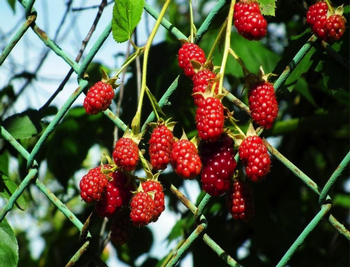Berry
-
Scientific NameRubus spp
-
General InformationBlackberries and raspberries are deciduous vines that do best when trellised. Boysenberries are a hybrid cross of blackberries and raspberries. These plants have perennial roots and biennial shoots or canes that give us fruit in the second year.
 Photo: Bezkolcowa, Pixabay
Photo: Bezkolcowa, Pixabay -
When to Plant
Plant mid-January to March, using certified pest-free nursery stock. In winter, bare root plants are sold in containers. Vines become productive in about three years.
-
Planting
Plant berries in well-drained, acidic soil. Plant blackberries four to six feet apart, raspberries two to three feet apart. Cover crowns with one-inch of soil. Berries can be located along a trellis or fence made from an open material like hog wire. After planting, cut back to about two inches high so new canes will form from roots.
-
Soil Requirements
Berries prefer well-drained, acidic to neutral soil (pH 5.5 to 7). Test soil prior to planting. Adding peat moss, elemental sulphur, or aluminum sulfate can lower soil pH about one point. Compost containing pine needles, coffee grinds, and oak leaves will add organic matter and loosen up compacted soils, and may minimally help acidify soil. Reducing soil pH can take at least six months and up to one year. Note: The most effective approach is to add elemental sulphur over several years and monitor changes with annual testing.
-
Water Requirements
Water consistently. After rains have stopped, irrigate at least one- inch of water per week and more during hot spells.
-
Fertilizing
Berries require about one-quarter pound of nitrogen every year, divided into applications in the spring, summer and fall. If using compost and organic fertilizers such as blood meal, fish meal, and organic fertilizer blends available from the local nursery, apply in early winter. If vegetative growth looks sparse, add fertilizer at bloom.
-
Pollination
Although these berries are self-pollinating, research shows fruits are larger when bees visit. Hollow stems of vines often serve as nesting sites for native bees.
-
Harvesting
Depending upon variety, berries ripen 40 to 60 days after bloom, from about June through October. Harvest only when berries easily fall off the stem. They do not ripen further after harvest.
-
Storage
Berries have a short shelf life. Store in the refrigerator in a shallow container for up to two days.
-
Good Varieties for Marin
There are erect and trailing berry vines, available in thorny and thornless varieties. Some berries produce early and some late. These three interesting varieties are often available in Marin:
‘Black Satin’ blackberry -- thornless and requires trellis support.
‘Raspberry Shortcake’ raspberry -- thornless and requires no support.
‘Thornless’ boysenberry -- requires support. -
Helpful Tips
To maintain moisture and control weeds, mulch annually.
To avoid pests and diseases, select disease-free and disease-resistant plants.
Pruning
Blackberries:
Little pruning is done on blackberries during the first year. In subsequent years, prune once in winter and once after harvest.Raspberries:
On summer bearing raspberries, prune spent canes after harvest by cutting them to the ground. In April, prune first flush of new canes when growth is seven to ten inches high. New canes will develop. Remove spent canes any time after harvest.For fall bearing varieties, either remove top half of canes after fruiting to produce a crop the following June, or remove entire cane to the ground to get a crop the following fall.
-
Common ProblemsN / A
-
Pests- Diseases & More
Berries are susceptible to scale, borers, raspberry horntail, worms, and spider mites. Control scale by controlling ants and cut out scale, borers, and worms. Hose off spider mites. In wet weather, drosophila (fruit flies) can be a problem. To control, harvest berries more frequently and pick up fallen fruit.
Learn more about growing berries.

